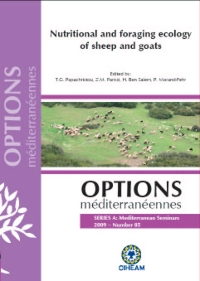| Article précédent | p. 159-164 | Article suivant |
Effect of fertilization and artificial shading on N and various mineral content of herbaceous species
Minerals and N have a significant impact on animal performance. The objective of this study was to investigate the effect of fertilization and artificial shading on N and various mineral contents of the above ground biomass content of the species Festuca ovina, Dactylis glomerata, Trifolium repens and Trifolium pratense. Three artificial shade treatments with 90%, 80% and 70% reduction of the total radiation and the control (0%) were tested. Species sowed in pots with soil from a Pinus brutia forest understorey. Six pots of each species were placed in each shade treatment and the control. Half of these pots were fertilized with 225 kg/ha of N, 450 kg/ha of P and 225 kg/ha of K after the sowing. Additionally, 395 kg/ha of NH4NO3 were top-dressed in April. At the end of the growing season the herbage biomass of each pot was cut at ground level and sampled. The samples were oven-dried at 60°C for 48 h and subsequently analyzed for N, P, Ca, K and Na. Shading treatments increased N content in grasses compared to control (P < 0.05). On the other hand, N content increased in legumes only at 90% shading (P < 0.05). There was no significant effect of the shade and fertilization on Ca (P > 0.05). Fertilization significantly increased the P content in grasses and did not affect it in legumes. The effect of fertilization and shade in K content strongly depended on plant species. Fertilization affects the content of Na only in sun, while the effect of shade depended on plant species. The content of N as well as P, Ca and K content except Na both in grasses and legumes were putatively sufficient to meet small ruminants' maintenance demands. To conclude, a diversity of plant species should be offered to small ruminants grazing pine-based understorey in order to offer them the opportunity to select a balanced diet.
Les minéraux et l'azote ont un impact significatif sur les performances animales. L'objectif de ce travail était d'étudier l'effet de la fertilisation et de l'ombrage artificiel sur les teneurs en azote et en différents minéraux de la partie aérienne de Festuca ovina, Dactylis glomerata, Trifolium repens et Trifolium pratense. Trois types d'ombrage artificiel ont été évalués : 90%, 80% et 70% de réduction de l'irradiation totale. Ces traitements ont été comparés à un témoin (0%). Les espèces végétales susmentionnées ont été semées dans des pots remplis de terre provenant d'une forêt de Pinus brutia. Six pots de chaque espèce ont été placés sous chaque type d'ombrage artificiel et le témoin. La moitié de ces pots a été fertilisée avec 225 kg/ha d'azote, 450 kg/ha de potassium après semis. En outre, 395 kg/ha de NH4NO3 ont été épandus en avril. A la fin de la saison de croissance, la biomasse végétale au niveau de chaque pot a été coupée à ras de sol et échantillonnée. Les échantillons ont été séchés à 60°C pendant 48 h puis analysés pour leurs teneurs en N, P, Ca, K et Na. Comparé au témoin, l'ombrage artificiel a entraîné une augmentation de la teneur de l'herbe en azote (P < 0,05). L'augmentation de la teneur en azote dans les légumineuses a été notée uniquement avec le traitement 90% d'ombrage (P < 0,05). La teneur en Ca n'a été affectée ni par l'ombrage ni par la fertilisation. La fertilisation a augmenté la teneur en P uniquement des graminées. L'effet de cette fertilisation et de l'ombrage sur la teneur en K a varié en fonction de l'espèce végétale. La fertilisation affecte la teneur en Na uniquement lorsque la plante est exposée au soleil, alors que l'effet de l'ombre dépend de l'espèce végétale. Excepté le Na, les teneurs en N, P, Ca et K chez les graminées et les légumineuses permettent de couvrir les besoins d'entretien des petits ruminants. En conclusion, la diversification des espèces fourragères destinées aux petits ruminants pâturant dans des forêts à base de pins est recommandée pour leur permettre de sélectionner une ration équilibrée.
- [ Afficher ]
- [ Télécharger ]
- [ Exporter la citation ]
Vous pouvez télécharger la citation au format :
- [ Imprimer ]
-
Mots-clés
AZOTE, FERTILISATION, GRAMINEE FOURRAGERE, LEGUMINEUSE FOURRAGERE, MINERAUX, NUTRITION ANIMALE, OMBRAGE, RUMINANTCiter cet article
Parissi Z.M., Koukoura Z. Effect of fertilization and artificial shading on N and various mineral content of herbaceous species. In : Papachristou T.G. (ed.), Parissi Z.M. (ed.), Ben Salem H. (ed.), Morand-Fehr P. (ed.). Nutritional and foraging ecology of sheep and goats. Zaragoza : CIHEAM / FAO / NAGREF, 2009. p. 159-164. (Options Méditerranéennes : Série A. Séminaires Méditerranéens; n. 85). 12. Seminar on: Nutritional and Foraging Ecology of Sheep and Goats, 2007/10/11-13, Thessaloniki (Greece). http://om.ciheam.org/om/pdf/a85/00801001.pdf



